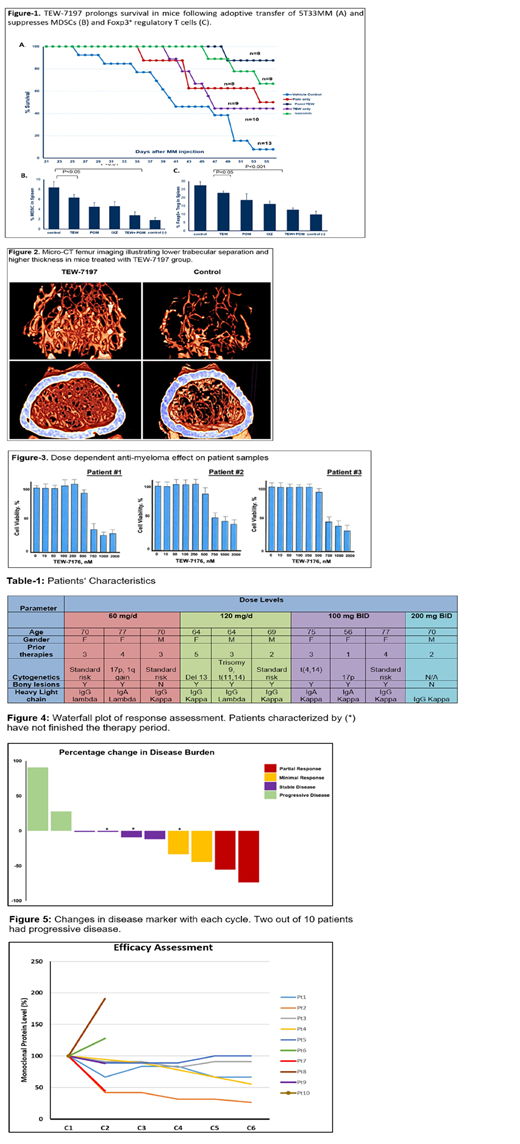Multiple Myeloma (MM) is a neoplasm of terminally differentiated plasma cells which proliferate in a permissive bone marrow environment characterized by immunosuppression and osteoclast activation. Although malignant plasma cells do not harbor any mutation in the Transforming Growth Factor-beta (TGF-β) pathway, increased TGF-β secreted by MM cells lead to impaired immune surveillance and promotion of catabolic bone remodeling allowing myeloma progression (Kyrtsonis MC et al. 1998). Here, we conducted preclinical studies in the syngeneic 5T3MM immunocompetent mouse model assessing the efficacy of vactosertib (Vacto), a TGF-β type I receptor antagonist, single agent activity as well as synergistic activity with the third generation immunomodulatory drug, pomalidomide (Pom) and a subsequent corticosteroid-free phase I study to test safety and preliminary efficacy of this combination. (NCT03143985).
Methods
Preclinical: Mice bearing 5T33MM cells expressing luciferase were treated with Vacto/Pom and the combination for 3 weeks, and evaluated for MM growth by bioluminescence imaging (BLI). Cellular and molecular assays were performed in human RPMI8226 and U266 as well as murine 5T33MM cells via apoptosis, real-time PCR and Western blotting. Peripheral blood monoclonal protein concentration, M-spike, was measured by ELISA. Distal femur trabecular bone structure was assessed by 3D micro-CT. Phase I: pts with relapsed MM with at least two lines of therapies enrolled on a modified Fibonacci 3 + 3 dose escalation design and received escalating dosages of Vacto, 60 mg/d, 120 mg/d and 100 mg BID and 200 mg BID in combination with standard dose of Pom (4mg) without corticosteroids. The study objectives were to assess safety, recommended phase 2 dose, and efficacy of Vacto/Pom in compared to historical control of Pom without corticosteroids (PFS-6: 20% in randomized Phase II study by Richardson et al. Blood. 2014). Vacto tablets, taken daily for 5 days followed by 2 days off, was administered in 28-day cycles, repeated for 6 cycles or until progression of disease or intolerable toxicity. There was no fasting requirement after the first two dose levels.
Results:Preclinical: Vacto attenuated the growth and viability of human and murine MM cells by inducing apoptosis and inhibited TGF-β-induced activation of Smad2/3 in MM cells in vitro. In the 5T33MM preclinical model, Vacto inhibited MM progression, as single agent, as measured by peripheral blood monoclonal protein concentration and BLI before and after treatment. Vacto also prolonged survival (Figure-1), prevented weight loss and increased trabecular bone thickness (Figure-2) in mice bearing MM in compare to control. Vacto alone or combination with Pom also attenuated TGF-β activation of Smad2/3, reduced the expansion of CD11b⁺Gr-1⁺ myeloid derived suppressor cells (MDSCs) in the bone marrow, and diminished the population of Foxp3⁺ regulatory T cells in the spleen (Figure-1). Vacto showed anti-myeloma effect at level of 700-750 nM on myeloma cells from three MM pts (Figure-3). Phase I: As of July 30th 2019, 10 pts were enrolled in the study (Table-1). Three pts were refractory to bortezomib and four pts were refractory to lenalidomide. The most common non-hematologic adverse event (AE) was grade II fatigue and pain in one pt with one episode of grade III renal failure that took less than 7 days to get back to baseline, no grade IV non-hematologic AE was observed. Two pts had grade III hematologic AE, no grade IV hematologic AE. Two out of 10 patients experienced progression of disease (PFS-6: 80%) (Figure-4, 5).
Conclusions: Vacto is a small molecule TGF-β type I receptor inhibitor that has shown single agent activity against myeloma in the syngeneic 5T33MM murine mouse model, in human myeloma cell lines and primary patient samples. Its effect on the tumor microenvironment is augmented in combination with Pom in the Cereblon-negative immunocompetent murine model. The phase I data shows safety of this agent in combination with Pom. The preliminary efficacy assessment is PFS-6: 80% which is higher than historical control (Richardson et al. Blood. 2014) with Pom only (PFS-6: 20%) or Pom with corticosteroids (PFS-6: 40%). Further advancement of this agent in clinical trial pipelines for MM is planned.
Malek:Amgen: Speakers Bureau; Adaptive: Consultancy; Janssen: Speakers Bureau; Medpacto: Research Funding; Sanofi: Consultancy; Takeda: Consultancy; Celgene: Consultancy. Hwang:MedPacto: Employment. Metheny:Takeda: Speakers Bureau; Incyte: Speakers Bureau.
Experimental therapeutics: Vactosertib
Author notes
Asterisk with author names denotes non-ASH members.


This feature is available to Subscribers Only
Sign In or Create an Account Close Modal